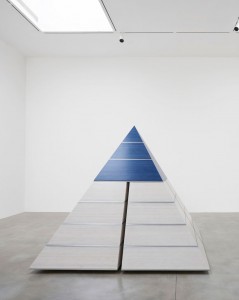ART-PRESENTATION:Sam Gilliam-Existed Existing
![]() Sam Gilliam is a leading African American abstractionist, and a key figure of American post-war painting. As an innovator within the Washington Colour School, Sam Gilliam’s art pushed the boundaries of color field abstraction. He is recognized as the first artist to introduce the idea of a draped, painted canvas hanging without stretcher bars around 1965. This was a major contribution to the Color Field School. Recent works in various media continue to blur the lines between painting and sculpture.
Sam Gilliam is a leading African American abstractionist, and a key figure of American post-war painting. As an innovator within the Washington Colour School, Sam Gilliam’s art pushed the boundaries of color field abstraction. He is recognized as the first artist to introduce the idea of a draped, painted canvas hanging without stretcher bars around 1965. This was a major contribution to the Color Field School. Recent works in various media continue to blur the lines between painting and sculpture.
By Efi Michalarou
Photo: Pace Gallery Archive

Sam Gilliam’s solo exhibition “Existed Existing” features three new bodies of work that include large-scale paintings, some titled as tributes to influential Black contemporary and historical figures; a series of geometric color-drenched wood objects; and monochromatic paintings on Japanese washi paper. Gilliam’s new sculptural works take the form of geometric objects: pyramids, parallelograms, and circles made from stacked and stained plywood and aluminium. These new sculptures developed following Gilliam’s extended stay in Basel, Switzerland, for the installation of his exhibition at the Kunstmuseum Basel in 2018, where he noticed that the city’s population had grown more international through an influx of immigrants, primarily from Africa. Inspired by this urban change and African influence, Gilliam returned to his studio and began to revisit the elemental forms of ancient African architecture. At the centre of the exhibition is a series of new large-scale paintings that further meditate on the physicality of color. Several of these works pay homage to Gilliam’s Black heroes, from singer-songwriter Beyoncé and tennis player Serena Williams to Senator John Lewis, the late civil rights leader who passed away this year. Densely layered and mixed with sawdust and other detritus from the studio, Gilliam flings, spatters, and throws paint to create fields of color interrupted by impressions of the artist’s hand, the mark of a palette knife, or the traces of a garden rake dragged across the wet surface. Continuing his series of signature beveled-edge paintings, which began in the 1960s, these canvases at first appear to emerge from the wall toward the viewer. The density of the paintings at first disguises the depth of the canvas’s bevel, giving the illusion of flatness. As if offering an infinite space in their depth, each painting seems to oscillate between liquid and solid when viewed from different distances. Complementing Gilliam’s new large-scale paintings and sculptural structures is a series of monochromatic paintings on traditional Japanese washi paper, handmade from the inner bark of specific trees and plants. To make these works, Gilliam drenches the paper repeatedly in applications of rich, monochromatic color. Gilliam’s three new bodies of work are unified by a performative sensibility: the relationships between music, art, and dance that are fundamental to his practice. Music has always been a grounding presence in the artist’s life and a strong influence on his creative output. Growing up amid the rich musical culture of Tupelo, Mississippi, Gilliam was exposed to Billie Holiday and Muddy Waters at a young age and most of his family members were musical, including Gilliam himself, who sang and played the harmonica. He credits jazz saxophonist John Coltrane for teaching him how to paint:
Info: Pace Gallery, 540 West 25th Street, New York & 510 West 25th Street, New York, Duration: 6/11-19/12/2020, Days & Hours: Tue-Sat 10;00-17:00 (by appointment only), www.pacegallery.com



